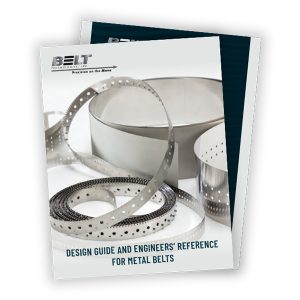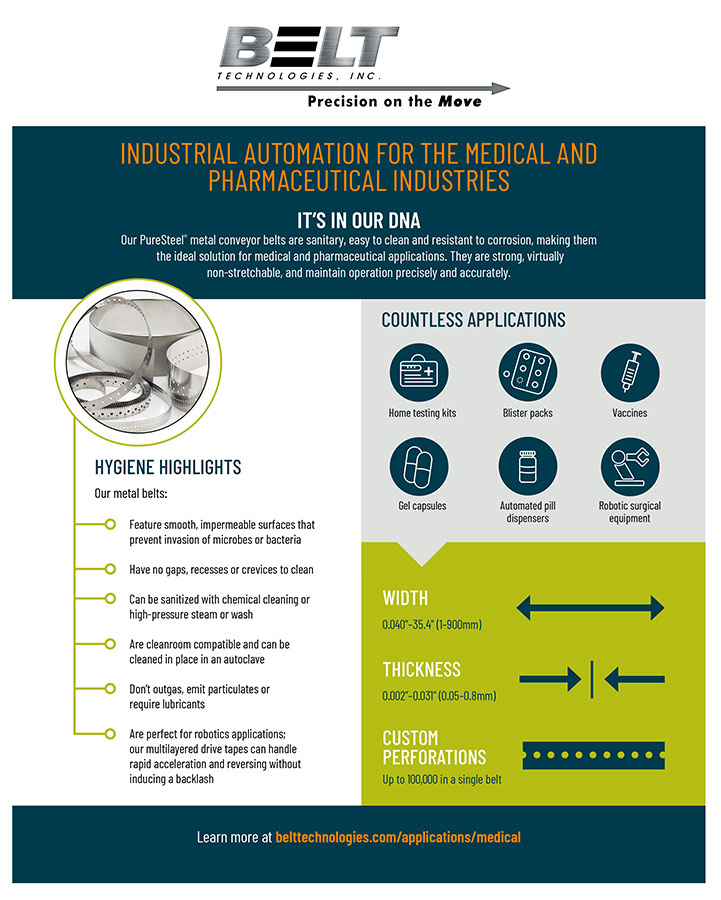Manual Assembly Processes Are Slow, Inconsistent, and Inefficient
Making the food safety test kits involved filling disposable packages with a liquid testing medium, curing the trays on a heated conveyor system, and finally packaging them in sealed blister packs—all in a clean room environment.
Formerly, the line workers filled the test kits by hand and then manually placed them on the conveyor, where they travelled on a mesh wire belt over a heating element. The mesh belt did not transfer heat evenly, which had a detrimental effect on product quality and consistency. If the kit did not cure properly during the heating process, it could incur unexpected costs for lost product and time.
Designing and Building New Metal Belt Conveyor System for Full Automation
Belt Technologies suggested replacing the wire mesh belt with a conveyor made of 301 full hard stainless steel, which would result in a stronger, flatter belt surface. 301 full hard stainless steel would be able to withstand the high temperatures of the heating process; also, the superior thermal conductivity of solid stainless steel would provide better heat distribution.
The customer made a prototype model of the new conveyor system featuring a solid, endless metal belt to replace the mesh belt for improved heat transfer and reliability. Belt Technologies supplied the belts for this model. The first order for the proof of concept was for a belt, pulleys, and roll holders. The customer built their own conveyor using these components. Once the prototype had successfully proven the concept, they turned to Belt Technologies to produce a full-scale conveyor system (approximately 20 feet long). The customer provided their own heating platens for the system and Belt Technologies integrated these components into the conveyor system.
The conveyor belt for this system runs through an acrylic glass tunnel during the heating process, so it was important that the belt stayed on track. If the belt were to run off track and unnoticed through several cycles, it could potentially damage the entire system. This could be avoided with constant monitoring and adjustment, but would be a challenge and could require hiring and training new employees. Based on the suggestions of Belt Technologies engineers, they chose to force track the belt with a silicone v-guide system. Silicone is a good choice for v-guide material as it is able to withstand high-temperature environments. Forced tracking provides a long-term value by eliminating the need for manual tracking adjustments, unnecessary maintenance downtime, or additional training-related costs.
New Automated Stainless Steel Conveyor Increases Product Throughput & Quality
In addition to correcting the uneven heat transfer, the customer wanted to further automate the system by adding robotic arms to fill and place the test kits. A perforated drive tape was selected to actuate precise robotic arm movement and allowed them to fill and cure at triple the rate they achieved with hand filling and placement.
This conveyor system was easily integrated with the existing automated packaging equipment. While the test kits originally had to be hand-checked for quality (to guarantee proper curing) and then manually transferred to packaging, the kits can now seamlessly move from filling to heat curing to heat-sealing in blister packs, and then finally to packaging, for shipment.
The first conveyor was such a success, the customer was able to expand production and ordered several additional units.



